
Characiformes is an order of ray-finned fish, comprising the characins and their allies. Grouped in 18 recognized families, more than 2000 different species are described, including the well-known piranha and tetras.
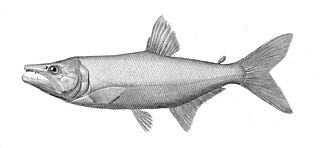
Acestrorhynchus is a genus of 14 species of characiform fish found only in fresh water in South America, the sole genus in the family Acestrorhynchidae. Their greatest diversity is in the Orinoco and Amazon basins.

The Ctenoluciidae, also known as pike-characins, are a small family of freshwater fishes from Panama and South America.

Hepsetus odoe, the African pike characin, is a predatory freshwater characin belonging to the family Hepsetidae. It was formerly considered that there was a single species of Hepsetus pike characin but recent studies have led to the species being split and Hepsetus odoesensu stricto is the west African representative of the group.
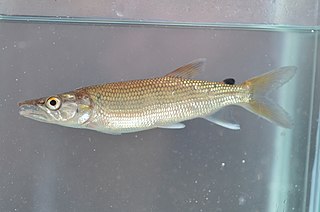
Hepsetus is a genus of African fishes, the African pikes or African pike characins, in the order Characiformes. It is the sole genus in the family Hepsetidae. It was long believed that only a single widespread species existed, H. odoe, but studies in 2011–2013 have shown that this species is restricted to parts of West and Central Africa. The well-known species of southern Africa, including Kafue River, is Hepsetus cuvieri. These predatory fish reach up to 44 cm (17 in) in length.

Synodontis is the largest genus of mochokid catfishes. It is the biggest genus within the 10 genera and 190 different species in the family Mochokidae. Synodontis has over 131 different species within the genus. Synodontis are also known as squeakers, due to their ability to make stridulatory sounds through their pectoral fin spines when handled or disturbed. Synodontis make a sound that sounds like squeaking by rubbing their spines together. They do this when they have been frightened or when they become angry. Synodontis may also squeak when they are taken out of the water. These catfish are small- to medium-sized fish with many species exhibiting attractive spotted markings. Some species are also known for naturally swimming belly-up, earning the name upside-down catfish. Some of these species are Synodontis contractus and Synodontis nigriventris. While some of these species are known to swim upside down, another species, Synodontis multipunctatus, is a brood parasitic cuckoo catfish,there are two other species Synodontis petricola and Synodontis grandiops are also called brood parasitic cuckoo catfish.

Alestes is a genus in the family Alestidae, known as the "African Characidae" as they are found exclusively on that continent. As suggested by that name, they Alestidae was formerly included in Characidae. Myletes is a synonym of Alestes, but the former name has historically also been used for various South American serrasalmids.

Hydrocynus is a genus of large characin fish in the family Alestidae commonly called "tigerfish," native to the African continent. The genus name is derived from Ancient Greek ὕδωρ ("water") + κύων ("dog"). The genus contains five species, all popularly known as "African tigerfish" for their fierce predatory behaviour and other characteristics that make them excellent game fish. Hydrocynus are normally piscivorous, but H. vittatus is proven to prey on birds in flight.
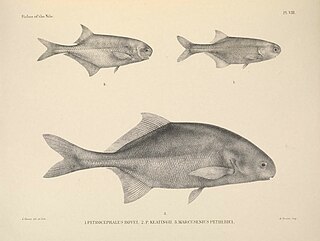
Petrocephalus is a genus of ray-finned fish in the family Mormyridae. All the fish species of this genus are endemic to Africa.

Alestopetersius is a genus of characins, fish found mostly in Congo River Basin in Middle Africa with one species from the lower Niger River in Nigeria. There are currently 10 described species in this genus.

Brachychalcinus is a genus of characins found in tropical South America, with five currently described species:
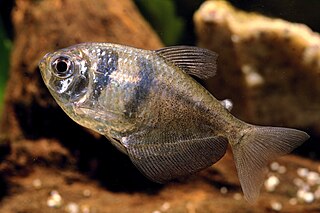
Gymnocorymbus is a genus of small characins from the Amazon, Paraguay, Orinoco, Courantyne, Gurupí and Parnaíba river basins in South America. These tetras are popular in the aquarium trade.
Pseudocheirodon is a genus of characins found in southern Central America. There are currently two described species in this genus.
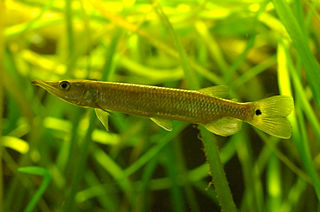
Ctenolucius is a genus of pike-characins found in southern Central America (Panama) and northwestern South America. The currently described species in this genus are:
Pseudocurimata is a genus of toothless characins found in tropical South America, with these currently described species:

Phago is a genus of distichodontid freshwater fishes found in tropical West and Middle Africa. They reach up to 17 cm (6.7 in) in total length, are slender in their overall shape and have a beak-like snout. They are specialized fin-eaters, but may on occasion also feed on insects and (whole) fish.
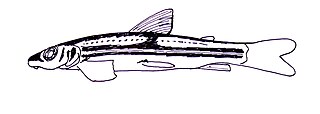
Parodon is a genus of scrapetooths from South America, which can be found as far south as Río de la Plata.
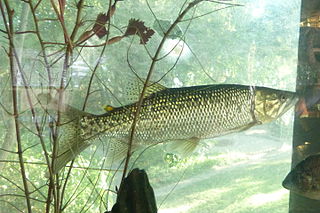
Hepsetus cuvieri, sometimes known as the African pike or Kafue pike characin, is a predatory freshwater fish found in southern Africa. This species was described in 1861 by the French naturalist Francis de Laporte de Castelnau.
Acestrorhynchus pantaneiro, known commonly as the pike characin, is a species of fish in the family Acestrorhynchidae. It was described by Naércio Aquino de Menezes in 1992. It inhabits the La Plata, Paraná, Paraguay, Uruguay, and Mamoré Rivers. It reaches a maximum total length of 35.2 cm (13.9 in), and a maximum weight of 396 g (14.0 oz).

The pike characin is a species of fish in the family Acestrorhynchidae. It was described by Sir William Jardine, 7th Baronet in 1841, originally under the genus Hydrocyon. It inhabits the Orinoco and Amazon Rivers in the regions of Suriname, Guyana, and French Guiana, at a pH range of 5.5-6.5. It reaches a maximum total length of 37 cm (15 in), and a maximum weight of 230 g (8.1 oz).

















